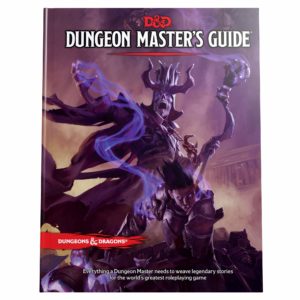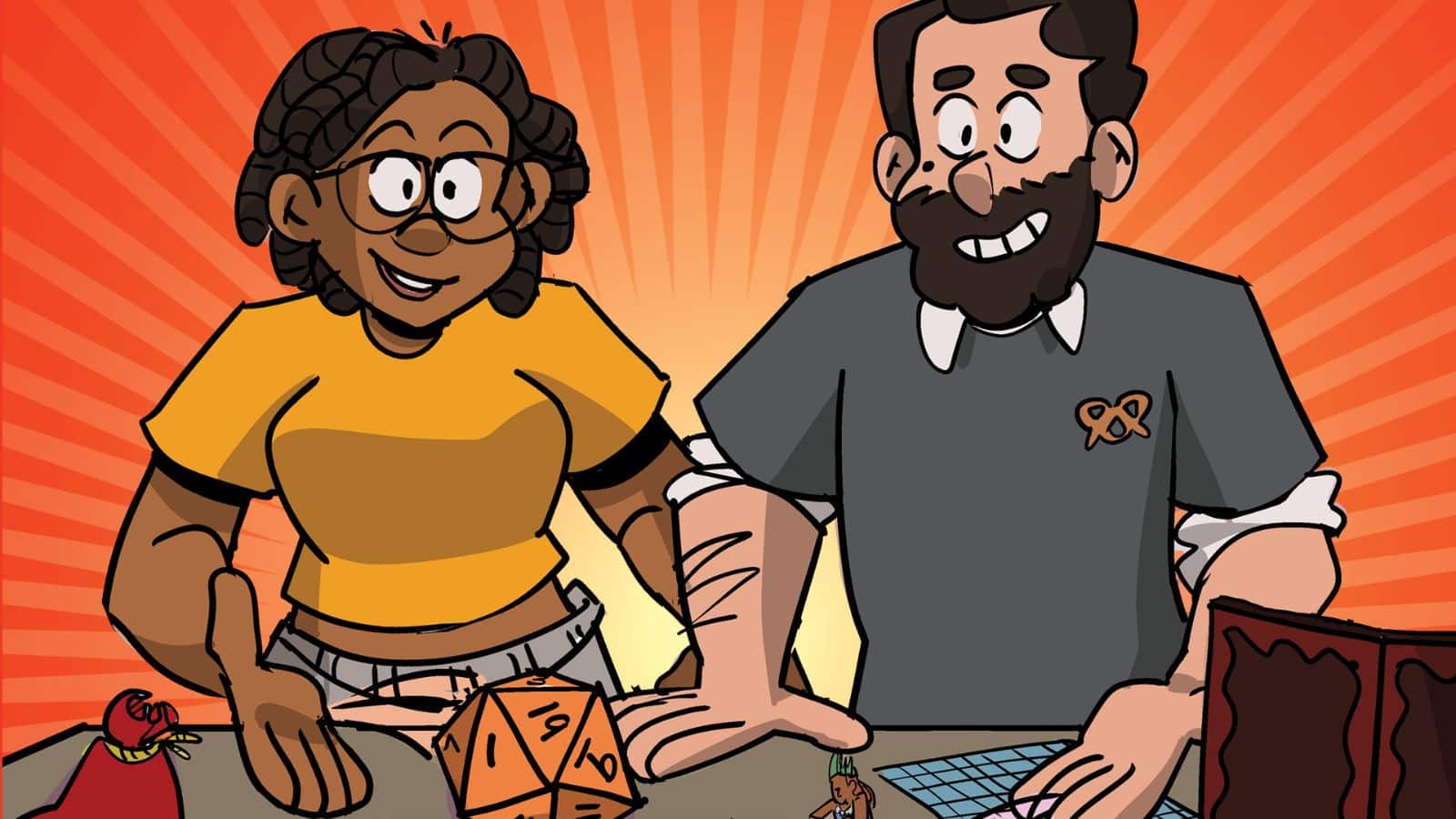By Andrew Dmytrasz

If it is your first time running a campaign, going with a starter set is your best bet. It has the campaign outlined for you, a brief overview of how to run the game, and what to expect out of your players. Believe it or not, if you are a new DM, then you are better off getting the Player’s Handbook rather than the Dungeon Master’s Guide. That’s because the DM guide is aimed towards people who want to create their own campaign from scratch, which can get a little overwhelming for a first-time Dungeon Master. The Player’s Handbook, meanwhile, is one you should familiarize yourself with in order to run a smooth campaign for your adventurers.
Once you’ve established what kind of campaign you want to run, here are some tips for getting started as a Dungeon or Game Master.
Establish expectations and guidelines for your players
As the DM, before you even start your campaign, it is up to you to establish expectations and guidelines for the players. What happens if players split up? Can they share information with each other? Should they? And what happens if a player dies? It’s also useful to establish guidelines for players who may want to retract what their character said or did.
Similarly, it’s worth creating standards of play. These may include deciding if you will roll your dice in front of your players or hide them (perhaps behind a DM screen, like the one provided in the Essentials Kit), how you will deal with players missing a session or their characters going missing in the campaign, etc.
There are no wrong ways to establish these rules, and you don’t need to decide on every single one before the campaign starts, but you should keep them consistent throughout. Some rules or guidelines you won’t even think about until they come up during the campaign; others won’t occur to you until you have been playing for a while — for example, trying to play using the fewest dice rolls possible.
Plan ahead
When going with a pre-made campaign, you should read the campaign all the way through to see how everything connects and which people or storylines will be of importance. That way you know how you will need to steer your players. You don’t need to know everything or have everything memorized. Have everything you need in reach for things you would need to look up when the need arises.
Be honest: if it’s your first time running a campaign, let your players know! More than likely, they will be understanding and help you out. It is common for players and GMs to have their copies of the guides with them during sessions to look things up quickly for reference, or to check if they can actually do an action they have in mind.
Building your adventure party
More often than not, you may decide to try D&D or another tabletop roleplaying game because you see it on a show like Stranger Things, or you get into Critical Role or The Adventure Zone. So how do you find players who want to adventure with you?
When you mention D&D to people you know, everyone will have a different image or opinion of what it is to them. Some might think it involves dressing up as your character or having a huge display with miniatures; if that’s what you and your players want to do, then go for it, but it doesn’t have to be.
You should try and make your game as welcoming for everyone as you can in terms of letting people play at their comfort level. Some people may want to get really involved, dress up as their character and talk in a different voice for them, while others may not want to dress up at all and just use their regular voice. There is no rule that everyone must dress up or no one dresses up, and if players are setting those rules and making people uncomfortable, it is up to you to make sure everyone is having fun and enjoying themselves.
One way you can try and attract people to play is to relate it to a show or movie or character they really like and use that as an entry way for them. “You like Game of Thrones? Think of it as you being in the world with your own character. You like Captain America? You can make your character be a medieval version of Captain America.”
Get to know the players and their characters
While all players will be responsible for their own characters, it will be helpful to you if you can see the character sheets before the campaign starts; in fact, it may be useful to have copies of each character sheet accessible for you to reference, in case you have questions during a session that a player can’t or shouldn’t answer out loud. This allows you to work with your players to incorporate their character’s backstory and traits into the overall campaign, beyond just joining the adventure party.
In addition to trying to make sure the game runs smoothly, you also need to keep an eye on your players in terms of how well they understand the game, how they get along with each other, and what they enjoy. This will help you plan for each session: what things should you dedicate your time to and focus on? Maybe you need to spend more time explaining how ability checks work; maybe your players prefer heavy narration and investigation over combat.
Take notes each session to keep track of what your players’ characters have done. They don’t have to be super detailed, but who did they fight? What items did they acquire? What did they learn? Where did they go? You can incorporate these notes into future campaign sessions and the story.
Check in with your players
You should take time after you finish your session to talk with your players and get feedback from them. You are doing the campaign for them, so it is important you make it one they will enjoy. Ask them what they like: combat, the story element, interacting with the townspeople, adventuring, or something else. Maybe they want each session to focus on a different aspect or maybe they want all sessions to have a little bit of each. If the players are having fun and enjoying the campaign, they will get more involved and interested, and you will all have more fun.

Going above and beyond as a Dungeon Master
Once you get more comfortable running a campaign, you might look at different ways for how you can enhance your sessions and the overall game experience. You are telling a story, which includes building the world. I would not suggest trying to incorporate all of these elements into your first couple sessions as you might get overwhelmed by everything going on, but it can help to plan ahead and know what elements you may want to incorporate, so that you can adjust as your players get to know the campaign and the world
It may not be possible or affordable to incorporate all these elements into your sessions, but that is also not to say that you need all these elements in your sessions for them to be great. Try your best, work to your strengths, pay attention to what your players like, and make sure the players are enjoying themselves. At the end of the day, that’s all that really matters.
That said, if you want to get even more creative, here are some ideas for enhancing your campaign as a first-time DM or GM.
1. Voices
The truth is, incorporating different voices for your Non-Player Characters helps them stand out; this also helps your players get to know each NPC and really immerse themselves in the world you’ve created. Likewise, your players can use voices for their characters if they feel comfortable. This may seem simple, but don’t be upset if some of your players don’t want to adopt character voices. Some people may want to get creative and embody how their character talks and behaves, while other people may still be figuring out what their character is like. Some may never want to use a character voice, and that’s OK, but offering a safe space to do so (or not) can help everyone feel more involved.
2. Music
Setting the scene with music is another inexpensive way to enhance your sessions. Whether you are running a pre-made campaign or a custom campaign, you can likely find music that will accompany any scenario your players encounter from a battle, to exploring a forest, to sitting in a tavern. This will also aide you in storytelling; instead of telling people that they enter a bustling tavern with music playing, you can play the background music that gives them that information. It may take a couple of sessions for you to figure out how often you want music playing and whether you want something playing the entire time, or just to set the scene of a new location, or only during a boss fight to make it more epic. You can create your own playlists or even look for existing playlists that other people have made, of which there are dozens on YouTube and Spotify.
3. Miniatures
Miniatures are often unnecessary for a session or campaign, though it’s worth noting that some players will require visual representation of character movement, especially during battle. Miniatures can help with this, and they do add a certain charm. Some GMs are particular about battles in terms of keeping track of distance with regards to how close or far characters are in relationship to each other and to enemies. Others may not be so concerned, but either way, these visual markers can be useful. Miniatures are also useful if you are doing a dungeon crawl or exploring a cave and need to keep track of everyone’s position if a creature sneaks up from behind or a boulder comes at you from the side.
While individual miniatures themselves are not too expensive (around $5), if you want to buy miniatures for all your players or all your enemies, that can easily add up, especially when you add the cost of paint and brushes. Luckily, there are cheap alternatives to buying official character miniatures. There are toy machine dispensers at grocery stores that have miniature characters, or you can check out your local dollar mart and buy different coloured cubes or small stones.
Some people even create printable miniatures, like the resource site r-n-w, which also sells spell card packs and more physical props to help your players navigate the campaign. If these cheaper options serve to better your campaign, you can upgrade later or just carry on with what works! These are a good way to see if your group even wants to use miniatures, or to determine if they will just get in the way and slow things down.
4. Maps/Layouts
In most pre-made campaigns, they give you a small map of the different areas that the characters will be exploring to help give the GM a sense of the environment and space. Whether or not the GM should share that map with the players is a personal preference among GMs. Some don’t share, because it takes away from the characters exploring on their own and shows any hidden rooms or passageways. Others want to share so players can see all the different rooms and areas and decide for themselves which ones to explore, or possibly explore all of them to get all the details of the story. Some might do a third option where they only show the sections of the map that players have already explored.
If you are doing a pre-made campaign, then you will probably be using the map that comes with the campaign. If you are doing a custom campaign, you would need to make your own map, or download generic maps from creators that you can print and customize for your campaign. Not all of us are artists or have the skill to draw a map of what you may have in your head and how you want it to look. Luckily there are a multitude of resources, programs and sites to help you make your own map.
Making the jump to Dungeon or Game Master may feel intimidating, but if you communicate with your players and take advantage of the above tips and the below resources, you’ll master the skills in no time.
Helpful Links:
- 2-Minute Tabletop
- D&D Beyond
- Deepnight RPG Map Editor
- Inkarnate Mapmaker
- r-n-w
- Roll20
- Rolled and Told
- Wizards of the Coast
- 3 Tips for GMs to Mold Untapped New Player Potential
- 4 D&D Dungeon Mastering Tips Inspired by Critical Role
- 5 Fears of First-Time DMs and How to Vanquish Them
- 5 Tips for Dungeon Masters with Small Player Groups of Less Than 4
- GMs: Every Story Has These Elements So Use Them In Your Campaign
- How to Become a Better Game Master According to Science
- How to Level Up Your Mapmaking Skills
- How to Write the Best D&D Adventures Ever








